| Listing 1 - 10 of 10 |
Sort by
|
Book
ISBN: 2825708453 9782825708453 Year: 2003 Volume: *2 Publisher: Genève : Georg,
Abstract | Keywords | Export | Availability | Bookmark
 Loading...
Loading...Choose an application
- Reference Manager
- EndNote
- RefWorks (Direct export to RefWorks)
Pourquoi parler de la mort aujourd'hui ? Qu'est-ce que les anthropologues peuvent bien en dire ? Deux questions que le lecteur de cet ouvrage se posera sans doute. Ce livre - issu d'une recherche menée pour le Comité international de la Croix-Rouge (CICR) dans le cadre du projet sur les disparus en temps de conflits - a deux buts. Le premier est de présenter la diversité des rites funéraires dans le monde d'aujourd'hui. Les textes peuvent être lus comme des études ethnographiques sur la mort. Le second est d'illustrer la multiplicité des regards que les anthropologues portent sur la mort, le deuil et les funérailles. Les articles présentent donc toute la richesse de l'anthropologie actuelle et soulignent qu'un même objet - la mort - donne lieu à des éclairages extrêmement divers. Toutefois, nombre de pratiques funéraires semblent obéir à des structures rituelles communes : la mort est souvent conçue comme un passage et traitée comme telle. La conclusion synthétise, dans la mesure du possible, les très riches contributions. On y verra que la mort n'est nulle part innocente, que, partout, le pouvoir s'en mêle, que la souffrance des endeuillés est toujours accompagnée par le groupe et que les cosmogonies - biomédicale ou sorcellaire par exemple - donnent un sens à l'inquiétante étrangeté de la mort et suscitent des pratiques funéraires souvent apaisantes.
Funeral rites and ceremonies. --- Death --- Mourning customs. --- Social aspects.

ISBN: 9577394256 9789577394255 Year: 2003 Publisher: Taibei Shi : Wan juan lou tu shu gu fen you xian gong si,
Abstract | Keywords | Export | Availability | Bookmark
 Loading...
Loading...Choose an application
- Reference Manager
- EndNote
- RefWorks (Direct export to RefWorks)
Ethics --- Ethics. --- Funeral rites and ceremonies --- Funeral rites and ceremonies. --- Manuscripts, Chinese --- Manuscripts, Chinese. --- Mourning customs --- Mourning customs. --- China --- China.
Book
ISBN: 3447050012 Year: 2003 Publisher: Wiesbaden Harrassowitz
Abstract | Keywords | Export | Availability | Bookmark
 Loading...
Loading...Choose an application
- Reference Manager
- EndNote
- RefWorks (Direct export to RefWorks)
Laments --- Priests --- Pastors --- Clergy --- Priesthood --- Complancha --- Lamentations --- Elegiac poetry --- Mourning customs --- Political activity --- Staatliche Museen zu Berlin (Germany).
Book
ISBN: 5857592046 5857592151 Year: 2003 Publisher: Moskva : Indrik,
Abstract | Keywords | Export | Availability | Bookmark
 Loading...
Loading...Choose an application
- Reference Manager
- EndNote
- RefWorks (Direct export to RefWorks)
Church calendar --- Folk music --- Folk songs, Russian --- Folk songs, Russian --- Funeral rites and ceremonies --- Mourning customs --- Seasons --- History and criticism. --- History and criticism.
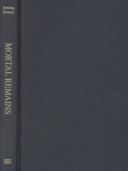
ISBN: 081221823X 1283898918 0812208064 Year: 2003 Publisher: Philadelphia : University of Pennsylvania Press,
Abstract | Keywords | Export | Availability | Bookmark
 Loading...
Loading...Choose an application
- Reference Manager
- EndNote
- RefWorks (Direct export to RefWorks)
Mortal Remains introduces new methods of analyzing death and its crucial meanings over a 240-year period, from 1620 to 1860, untangling its influence on other forms of cultural expression, from religion and politics to race relations and the nature of war. In this volume historians and literary scholars join forces to explore how, in a medically primitive and politically evolving environment, mortality became an issue that was inseparable from national self-definition.Attempting to make sense of their suffering and loss while imagining a future of cultural permanence and spiritual value, early Americans crafted metaphors of death in particular ways that have shaped the national mythology. As the authors show, the American fascination with murder, dismembered bodies, and scenes of death, the allure of angel sightings, the rural cemetery movement, and the enshrinement of George Washington as a saintly father, constituted a distinct sensibility. Moreover, by exploring the idea of the vanishing Indian and the brutality of slavery, the authors demonstrate how a culture of violence and death had an early effect on the American collective consciousness.Mortal Remains draws on a range of primary sources-from personal diaries and public addresses, satire and accounts of sensational crime-and makes a needed contribution to neglected aspects of cultural history. It illustrates the profound ways in which experiences with death and the imagery associated with it became enmeshed in American society, politics, and culture.
Death --- Funeral rites and ceremonies --- Social aspects --- History. --- Funerals --- Mortuary ceremonies --- Obsequies --- Manners and customs --- Rites and ceremonies --- Burial --- Cremation --- Cryomation --- Dead --- Mourning customs --- United States --- Social life and customs --- American History. --- American Studies. --- Cultural Studies.
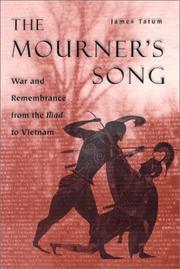
ISBN: 0226789934 Year: 2003 Publisher: Chicago (Ill.) : University of Chicago press,
Abstract | Keywords | Export | Availability | Bookmark
 Loading...
Loading...Choose an application
- Reference Manager
- EndNote
- RefWorks (Direct export to RefWorks)
American literature --- Epic poetry, Greek --- Memory in literature. --- Mourning customs in literature. --- Trojan War --- Vietnam War, 1961-1975 --- War in literature. --- War poetry --- War poetry, American --- History and criticism. --- History and criticism. --- Literature and the war. --- Literature and the war. --- History and criticism. --- History and criticism.
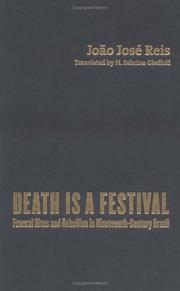
ISBN: 080786272X 9780807862728 0807827738 9780807827734 080785445X 9780807854457 9798890869746 Year: 2003 Publisher: Chapel Hill University of North Carolina Press
Abstract | Keywords | Export | Availability | Bookmark
 Loading...
Loading...Choose an application
- Reference Manager
- EndNote
- RefWorks (Direct export to RefWorks)
This award-winning social history of death and funeral rites during the early decades of Brazil's independence from Portugal focuses on the Cemiterada movement in Salvador, capital of the province of Bahia.
Funeral rites and ceremonies --- Cemeteries --- Insurgency --- Insurgent attacks --- Rebellions --- Civil war --- Political crimes and offenses --- Revolutions --- Government, Resistance to --- Internal security --- Burial grounds --- Burying-grounds --- Churchyards --- Graves --- Graveyards --- Memorial gardens (Cemeteries) --- Memorial parks (Cemeteries) --- Memory gardens (Cemeteries) --- Necropoleis --- Necropoles --- Necropoli --- Necropolises --- Burial --- Death care industry --- Funerals --- Mortuary ceremonies --- Obsequies --- Manners and customs --- Rites and ceremonies --- Cremation --- Cryomation --- Dead --- Mourning customs --- History --- History. --- Salvador (Brazil) --- Brazil --- Bahia (Brazil) --- Salvador da Bahia de Todos os Santos (Brazil) --- Bahia de Todos os Santos (Brazil) --- Prefeitura Municipal do Salvador --- Baía de Todos Santos (Brazil) --- Salvador de Bahia (Brazil) --- Social life and customs --- Funérailles --- Cimetières --- Révoltes --- Rites et cérémonies --- Histoire --- Salvador (Brésil) --- Brésil --- Moeurs et coutumes --- Prefeitura Municipal do Salvador (Brazil)
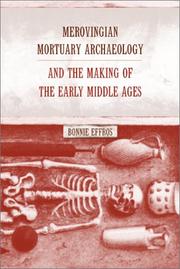
ISBN: 1282356704 9786612356704 0520928180 1597347434 9780520928183 0585467803 9780585467801 9780520232440 0520232445 9781597347433 0520232445 9781282356702 6612356707 Year: 2003 Publisher: Berkeley
Abstract | Keywords | Export | Availability | Bookmark
 Loading...
Loading...Choose an application
- Reference Manager
- EndNote
- RefWorks (Direct export to RefWorks)
Clothing, jewelry, animal remains, ceramics, coins, and weaponry are among the artifacts that have been discovered in graves in Gaul dating from the fifth to eighth century. Those who have unearthed them, from the middle ages to the present, have speculated widely on their meaning. This authoritative book makes a major contribution to the study of death and burial in late antique and early medieval society with its long overdue systematic discussion of this mortuary evidence. Tracing the history of Merovingian archaeology within its cultural and intellectual context for the first time, Effros exposes biases and prejudices that have colored previous interpretations of these burial sites and assesses what contemporary archaeology can tell us about the Frankish kingdoms. Working at the intersection of history and archaeology, and drawing from anthropology and art history, Effros emphasizes in particular the effects of historical events and intellectual movements on French and German antiquarian and archaeological studies of these grave goods. Her discussion traces the evolution of concepts of nationhood, race, and culture and shows how these concepts helped shape an understanding of the past. Effros then turns to contemporary multidisciplinary methodologies and finds that we are still limited by the types of information that can be readily gleaned from physical and written sources of Merovingian graves. For example, since material evidence found in the graves of elite families and particularly elite men is more plentiful and noteworthy, mortuary goods do not speak as directly to the conditions in which women and the poor lived. The clarity and sophistication with which Effros discusses the methods and results of European archaeology is a compelling demonstration of the impact of nationalist ideologies on a single discipline and of the struggle toward the more pluralistic vision that has developed in the post-war years.
Funeral rites and ceremonies --- Merovingians --- Funerals --- Mortuary ceremonies --- Obsequies --- Manners and customs --- Rites and ceremonies --- Burial --- Cremation --- Cryomation --- Dead --- Mourning customs --- Funeral rites and ceremonies. --- France --- Gaul --- Gallia --- Gaule --- History --- Antiquities. --- Social life and customs. --- Funeral customs and rites. --- Merovingians - Funeral rites and ceremonies --- Funeral rites and ceremonies - Gaul --- Gaul - Social life and customs --- Gaul - Antiquities --- France - History - To 987 --- ancient world. --- anthropology. --- antiquity. --- archaeology. --- aregund. --- art history. --- burial. --- celtic world. --- ceremonies. --- childeric. --- class. --- customs. --- dark ages. --- death. --- dying. --- early middle ages. --- europe. --- excavations. --- france. --- frankish kingdoms. --- french history. --- funerals. --- funerary. --- gaul. --- grave artifacts. --- graves. --- history. --- medieval history. --- medieval society. --- medieval. --- merovingian archaeology. --- merovingian graves. --- merovingians. --- monarchy. --- mortuary. --- nation. --- nonfiction. --- race. --- religion. --- rites. --- royalty. --- rulers. --- saint brice. --- social science. --- sociology. --- tombs.

ISBN: 0520232445 9780520232440 Year: 2003 Volume: 35 Publisher: California University of California press
Abstract | Keywords | Export | Availability | Bookmark
 Loading...
Loading...Choose an application
- Reference Manager
- EndNote
- RefWorks (Direct export to RefWorks)
Merovingians --- Funeral rites and ceremonies --- Gaul --- France --- Social life and customs --- Antiquities --- History --- Funeral rites and ceremonies. --- Antiquities. --- Social life and customs. --- -Merovingians --- -940.1 --- Funerals --- Mortuary ceremonies --- Obsequies --- Manners and customs --- Rites and ceremonies --- Burial --- Cremation --- Dead --- Mourning customs --- History Europe Middle Ages (476 - 1453) --- -Gaul --- -Gallia --- Gaule --- -Antiquities --- Archaeology, Medieval --- Tombs --- Mérovingiens --- Funérailles --- Archéologie médiévale --- Tombeaux --- Funeral customs and rites --- Rites et cérémonies funéraires --- Antiquités --- Rites et cérémonies --- Histoire --- Pʻŭrangsŭ --- Frankrig --- Francja --- Frant︠s︡ii︠a︡ --- Prantsusmaa --- Francia (Republic) --- Tsarfat --- Tsorfat --- Franḳraykh --- Frankreich --- Fa-kuo --- Faguo --- Франция --- French Republic --- République française --- Peurancih --- Frankryk --- Franse Republiek --- Francland --- Frencisc Cynewīse --- فرنسا --- Faransā --- Franza --- Republica Franzesa --- Gallia (Republic) --- Hyãsia --- Phransiya --- Fransa --- Fransa Respublikası --- Franse --- Францыя --- Frantsyi︠a︡ --- Французская Рэспубліка --- Frantsuzskai︠a︡ Rėspublika --- Parancis --- Pransya --- Franis --- Francuska --- Republika Francuska --- Bro-C'hall --- Френска република --- Frenska republika --- França --- República Francesa --- Pransiya --- Republikang Pranses --- Γαλλία --- Gallia --- Γαλλική Δημοκρατία --- Gallikē Dēmokratia --- فرانسه --- Farānsah --- צרפת --- רפובליקה הצרפתית --- Republiḳah ha-Tsarfatit --- פראנקרייך --- 法国 --- 法蘭西共和國 --- Falanxi Gongheguo --- フランス --- Furansu --- フランス共和国 --- Furansu Kyōwakoku --- Francija --- Ranska --- Frankrike --- To 987 --- History. --- Merovingians - Funeral rites and ceremonies --- Funeral rites and ceremonies - Gaul --- Gaul - Social life and customs --- Gaul - Antiquities --- France - History - To 987
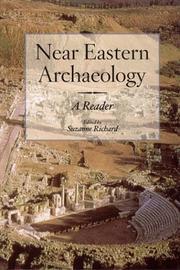

ISBN: 1575062348 1575065479 9781575065472 1575060833 9781575060835 Year: 2003 Publisher: University Park, PA
Abstract | Keywords | Export | Availability | Bookmark
 Loading...
Loading...Choose an application
- Reference Manager
- EndNote
- RefWorks (Direct export to RefWorks)
More than 60 essays by major scholars in the field have been gathered to create the most up-to-date and complete book available on Levantine and Near Eastern archaeology. -- Publisher description.
Archaeology --- Archeology --- Anthropology --- Auxiliary sciences of history --- History --- Antiquities --- History. --- Middle East --- Antiquities. --- Archäologie. --- Oudheid. --- Prehistorie. --- Archeologie. --- Weapons, Ancient. --- Underwater archaeology. --- Synagogues. --- Semitic languages. --- Scarabs. --- Samaritans. --- Numismatics. --- Mosaics. --- Metal-work. --- Jewish art. --- Jewelry. --- Iron age. --- Hieroglyphics. --- Funeral rites and ceremonies. --- Excavations (Archaeology) --- Church buildings. --- Ceramics. --- Canaanites --- Burial. --- Bronze age. --- Architecture, Ancient. --- Archaeology and religion. --- Archaeology. --- Archeologie --- Metal-work --- Weapons, Ancient --- Ceramics --- Jewelry --- Mosaics --- Scarabs --- Synagogues --- Samaritans --- Funeral rites and ceremonies --- Burial --- Church buildings --- Iron age --- Bronze age --- Jewish art --- Hieroglyphics --- Semitic languages --- Underwater archaeology --- Numismatics --- Architecture, Ancient --- Religion. --- Technological innovations. --- Histoire. --- Religion --- Bible. --- Bible --- Alter Orient. --- Middle East. --- Mediterranean Sea. --- Israel. --- Moyen-Orient --- Israel --- Antiquites. --- Funerals --- Mortuary ceremonies --- Obsequies --- Manners and customs --- Rites and ceremonies --- Cremation --- Cryomation --- Dead --- Mourning customs --- Samaritan religion --- Samaritanism --- Jews --- Jewish architecture --- Religious institutions --- Temples --- Ethnology --- Semites --- Amulets, Egyptian --- Insect forms in art and archaeology --- Decoration and ornament --- Decorative arts --- Ceramic technology --- Industrial ceramics --- Keramics --- Building materials --- Chemistry, Technical --- Clay --- Ancient weapons --- Arms and armor, Ancient --- Metalwork --- Manufacturing processes --- Metals --- Archaeological specimens --- Artefacts (Antiquities) --- Artifacts (Antiquities) --- Specimens, Archaeological --- Material culture --- Religion and archaeology --- History, Ancient --- Archaeology, Submarine --- Marine archaeology --- Maritime archaeology --- Nautical archaeology --- Submarine archaeology --- Underwater exploration --- Marine archaeologists --- Afroasiatic languages --- Ideography --- Inscriptions --- Paleography --- Writing --- Picture-writing --- Art, Jewish --- Hebrew art --- Judaism and art --- Art --- Civilization --- Burial customs --- Burying-grounds --- Graves --- Interment --- Public health --- Coffins --- Grave digging --- Churches --- Buildings --- Church facilities --- Church architecture --- Archaeological digs --- Archaeological excavations --- Digs (Archaeology) --- Excavation sites (Archaeology) --- Ruins --- Sites, Excavation (Archaeology) --- Jewellery --- Jewelry, Primitive --- Jewels --- Dress accessories --- Coloring --- Religious aspects --- Palestine --- Dawlat Isrāʼīl --- Država Izrael --- Dzi︠a︡rz︠h︡ava Izrailʹ --- Gosudarstvo Izrailʹ --- I-se-lieh --- Israele --- Isrāʼīl --- Isŭrael --- Isuraeru --- Izrael --- Izrailʹ --- Medinat Israel --- Medinat Yiśraʼel --- Stát Izrael --- State of Israel --- Yiselie --- Yiśraʼel --- Ισραήλ --- Израиль --- Государство Израиль --- Дзяржава Ізраіль --- Ізраіль --- מדינת ישראל --- ישראל --- إسرائيل --- دولة إسرائيل --- イスラエル --- 以色列 --- Mare Nostrum --- Orient --- Asia, South West --- Asia, Southwest --- Asia, West --- Asia, Western --- East (Middle East) --- Eastern Mediterranean --- Fertile Crescent --- Levant --- Mediterranean Region, Eastern --- Mideast --- Near East --- Northern Tier (Middle East) --- South West Asia --- Southwest Asia --- West Asia --- Western Asia --- Dzi͡arz͡hava Izrailʹ --- Eastern Mediterranean Region --- South West --- Asia --- Archaeology - Middle East - History. --- Middle East - Antiquities.
| Listing 1 - 10 of 10 |
Sort by
|

 Search
Search Feedback
Feedback About UniCat
About UniCat  Help
Help News
News